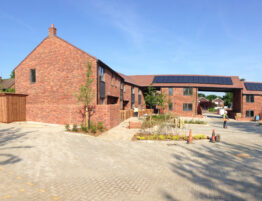
The UK government has recently announced that, under the Future Homes Standard (to be published this Autumn), the majority of new build properties will be required to include rooftop solar panels, unless site-specific factors such as shading make it impractical.
It’s a move designed to help households save on energy bills while cutting carbon emissions and boosting the UK’s energy security. In this week’s blog, we explore what the announcement means in practice, how the industry is reacting, and what housebuilders and developers should expect next.
What’s been announced – and why it matters
The Department for Energy Security and Net Zero, alongside the Ministry of Housing, has confirmed that new building regulations under the Future Homes Standard will “explicitly promote” the use of solar panels on new homes. This means most new houses will include solar panels by default, with some flexibility for shaded or tree-covered plots.
The aim? To reduce household energy bills and cut emissions from the moment people move in. Based on current energy price caps, a typical existing UK home can save around £530 a year by installing rooftop solar panels. And that’s before factoring in savings from pairing solar with battery storage or smart tariffs. With solar now present on 4 in 10 new homes, this change could quickly accelerate the rollout.
The government has made its position about the benefits of this change clear. Energy Secretary, Ed Miliband said:
“Solar panels can save people hundreds of pounds off their energy bills, so it is just common sense for new homes to have them fitted as standard. So many people just don’t understand why this doesn’t already happen. With our plans, it will.”
The changes form part of the Prime Minister’s wider Plan for Change, which also includes reforms to planning rules for heat pumps and upgrades to national grid infrastructure. From cooking and heating to EV charging, the goal is to help families power daily life using cheaper, homegrown clean energy.
What the industry is saying
Construction industry professionals have been responding to the announcement, with mixed views. Chris Hewett, Chief Executive of Solar Energy UK, is understandably among those welcoming the news:
“The solar industry is very glad to hear that almost all new homes will be fitted with solar power under the Future Homes Standard. Making solar panels a functional requirement of the building regulations will cut energy bills, lower carbon emissions, help drive polluting natural gas off the grid and improve our nation’s energy security.”
Joining the conversation, Chris O’Shea, CEO of Centrica, said:
“Our research shows that customers can shrink their energy bills by 90% when they combine solar and battery with the right energy tariff, and this announcement means even more households can soak up the savings—and the sunshine—by generating their own clean, free electricity.”
Others in the building sector are urging caution.
Richard Beresford, Chief Executive of the National Federation of Builders, warned:
“The main barriers to mandating solar panels on all new buildings are grid costs and grid delays. Although not yet fully resolved, the government have made real progress to fixing those issues, particularly through changes to the connection process, and planning reforms that ensure grid infrastructure funding goes further and faster.
“If grid connections are timely and not cost prohibitive, solar for new buildings is deliverable and we support that ambition. We urge the government to ensure planning is reformed so that councils cannot oppose solar on the grounds of being out of character.”
Rico Wojtulewicz, Head of Policy and Market Insight at both the NFB and the House Builders Association, also raised concerns about potential harm to local builders and the possibility of delays to tens of thousands of homes:
“No house-builder should be in a position where they are only able to provide connections for part of their site, receive no written promises on the date of connections and grid reinforcement, pay for temporary connections and then again for permanent ones, or be forced to fund infrastructure that the energy sector profits from in perpetuity. Without fair caveats to this policy, it will only weaken the broader construction industry and make the 1.5 million home target even harder to hit.”
What’s next?
The Future Homes Standard is set to be published in Autumn 2025, with regulatory changes likely to follow soon after. While the implementation timeline hasn’t been confirmed, the direction of travel is clear: solar is becoming a standard part of new build development.
Housebuilders and developers should therefore begin reviewing their specifications and engaging with architects, suppliers and energy consultants now. It’s also worth keeping up to date with local grid capacity issues and government guidance on flexibility for shaded plots or heritage areas.
Planning reforms and updates to connection processes are also underway, aiming to reduce delays and cost barriers. And with demand for qualified installers expected to rise, now may be a good time to build or strengthen partnerships in the low-carbon supply chain.
Over to you…
The government’s move to make solar panels a standard feature on new homes is a bold step toward a cleaner, more affordable energy future. For developers, it presents both opportunities and challenges – from rising demand for sustainable features to ongoing issues with grid access and planning.
We’d love to hear what you think. Will these changes support or strain housing development? Join the conversation and share your views on our Facebook or LinkedIn pages.
10.06.2025
Feature image: Freepik








